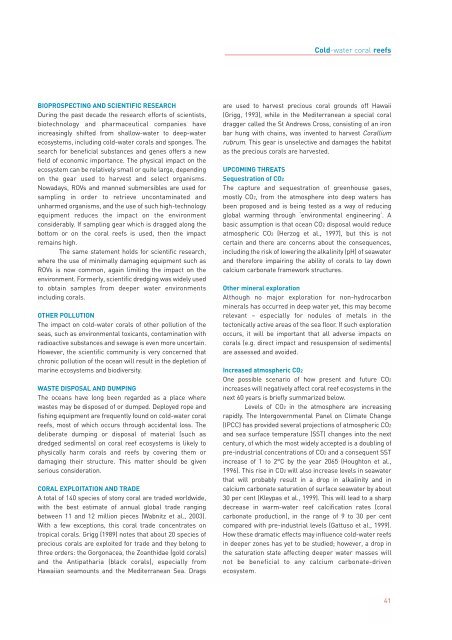Cold-water coral reefs - WWF UK
Cold-water coral reefs - WWF UK
Cold-water coral reefs - WWF UK
You also want an ePaper? Increase the reach of your titles
YUMPU automatically turns print PDFs into web optimized ePapers that Google loves.
<strong>Cold</strong>-<strong>water</strong> <strong>coral</strong> <strong>reefs</strong><br />
BIOPROSPECTING AND SCIENTIFIC RESEARCH<br />
During the past decade the research efforts of scientists,<br />
biotechnology and pharmaceutical companies have<br />
increasingly shifted from shallow-<strong>water</strong> to deep-<strong>water</strong><br />
ecosystems, including cold-<strong>water</strong> <strong>coral</strong>s and sponges. The<br />
search for beneficial substances and genes offers a new<br />
field of economic importance. The physical impact on the<br />
ecosystem can be relatively small or quite large, depending<br />
on the gear used to harvest and select organisms.<br />
Nowadays, ROVs and manned submersibles are used for<br />
sampling in order to retrieve uncontaminated and<br />
unharmed organisms, and the use of such high-technology<br />
equipment reduces the impact on the environment<br />
considerably. If sampling gear which is dragged along the<br />
bottom or on the <strong>coral</strong> <strong>reefs</strong> is used, then the impact<br />
remains high.<br />
The same statement holds for scientific research,<br />
where the use of minimally damaging equipment such as<br />
ROVs is now common, again limiting the impact on the<br />
environment. Formerly, scientific dredging was widely used<br />
to obtain samples from deeper <strong>water</strong> environments<br />
including <strong>coral</strong>s.<br />
OTHER POLLUTION<br />
The impact on cold-<strong>water</strong> <strong>coral</strong>s of other pollution of the<br />
seas, such as environmental toxicants, contamination with<br />
radioactive substances and sewage is even more uncertain.<br />
However, the scientific community is very concerned that<br />
chronic pollution of the ocean will result in the depletion of<br />
marine ecosystems and biodiversity.<br />
WASTE DISPOSAL AND DUMPING<br />
The oceans have long been regarded as a place where<br />
wastes may be disposed of or dumped. Deployed rope and<br />
fishing equipment are frequently found on cold-<strong>water</strong> <strong>coral</strong><br />
<strong>reefs</strong>, most of which occurs through accidental loss. The<br />
deliberate dumping or disposal of material (such as<br />
dredged sediments) on <strong>coral</strong> reef ecosystems is likely to<br />
physically harm <strong>coral</strong>s and <strong>reefs</strong> by covering them or<br />
damaging their structure. This matter should be given<br />
serious consideration.<br />
CORAL EXPLOITATION AND TRADE<br />
A total of 140 species of stony <strong>coral</strong> are traded worldwide,<br />
with the best estimate of annual global trade ranging<br />
between 11 and 12 million pieces (Wabnitz et al., 2003).<br />
With a few exceptions, this <strong>coral</strong> trade concentrates on<br />
tropical <strong>coral</strong>s. Grigg (1989) notes that about 20 species of<br />
precious <strong>coral</strong>s are exploited for trade and they belong to<br />
three orders: the Gorgonacea, the Zoanthidae (gold <strong>coral</strong>s)<br />
and the Antipatharia (black <strong>coral</strong>s), especially from<br />
Hawaiian seamounts and the Mediterranean Sea. Drags<br />
are used to harvest precious <strong>coral</strong> grounds off Hawaii<br />
(Grigg, 1993), while in the Mediterranean a special <strong>coral</strong><br />
dragger called the St Andrews Cross, consisting of an iron<br />
bar hung with chains, was invented to harvest Corallium<br />
rubrum. This gear is unselective and damages the habitat<br />
as the precious <strong>coral</strong>s are harvested.<br />
UPCOMING THREATS<br />
Sequestration of CO2<br />
The capture and sequestration of greenhouse gases,<br />
mostly CO2, from the atmosphere into deep <strong>water</strong>s has<br />
been proposed and is being tested as a way of reducing<br />
global warming through ‘environmental engineering’. A<br />
basic assumption is that ocean CO2 disposal would reduce<br />
atmospheric CO2 (Herzog et al., 1997), but this is not<br />
certain and there are concerns about the consequences,<br />
including the risk of lowering the alkalinity (pH) of sea<strong>water</strong><br />
and therefore impairing the ability of <strong>coral</strong>s to lay down<br />
calcium carbonate framework structures.<br />
Other mineral exploration<br />
Although no major exploration for non-hydrocarbon<br />
minerals has occurred in deep <strong>water</strong> yet, this may become<br />
relevant – especially for nodules of metals in the<br />
tectonically active areas of the sea floor. If such exploration<br />
occurs, it will be important that all adverse impacts on<br />
<strong>coral</strong>s (e.g. direct impact and resuspension of sediments)<br />
are assessed and avoided.<br />
Increased atmospheric CO2<br />
One possible scenario of how present and future CO2<br />
increases will negatively affect <strong>coral</strong> reef ecosystems in the<br />
next 60 years is briefly summarized below.<br />
Levels of CO2 in the atmosphere are increasing<br />
rapidly. The Intergovernmental Panel on Climate Change<br />
(IPCC) has provided several projections of atmospheric CO2<br />
and sea surface temperature (SST) changes into the next<br />
century, of which the most widely accepted is a doubling of<br />
pre-industrial concentrations of CO2 and a consequent SST<br />
increase of 1 to 2°C by the year 2065 (Houghton et al.,<br />
1996). This rise in CO2 will also increase levels in sea<strong>water</strong><br />
that will probably result in a drop in alkalinity and in<br />
calcium carbonate saturation of surface sea<strong>water</strong> by about<br />
30 per cent (Kleypas et al., 1999). This will lead to a sharp<br />
decrease in warm-<strong>water</strong> reef calcification rates (<strong>coral</strong><br />
carbonate production), in the range of 9 to 30 per cent<br />
compared with pre-industrial levels (Gattuso et al., 1999).<br />
How these dramatic effects may influence cold-<strong>water</strong> <strong>reefs</strong><br />
in deeper zones has yet to be studied; however, a drop in<br />
the saturation state affecting deeper <strong>water</strong> masses will<br />
not be beneficial to any calcium carbonate-driven<br />
ecosystem.<br />
41
















